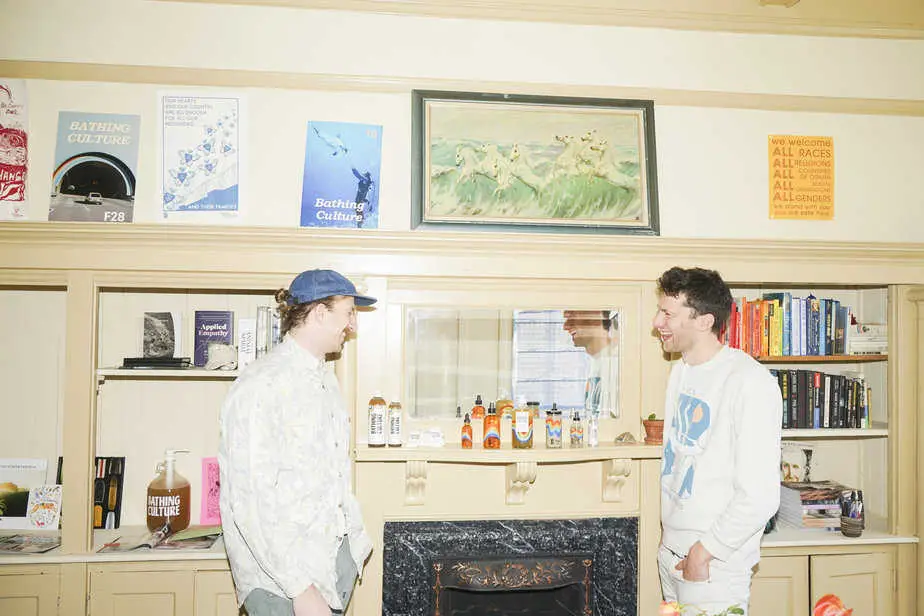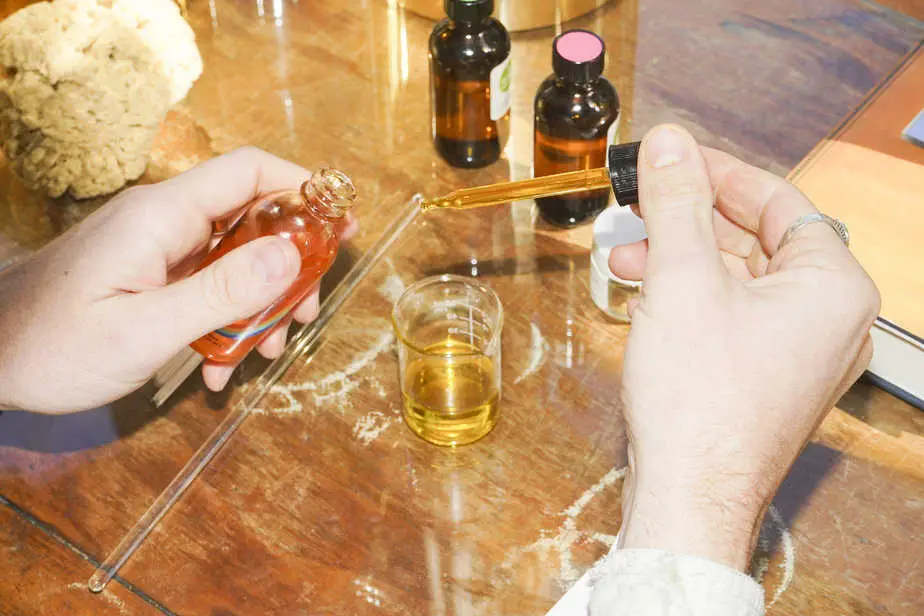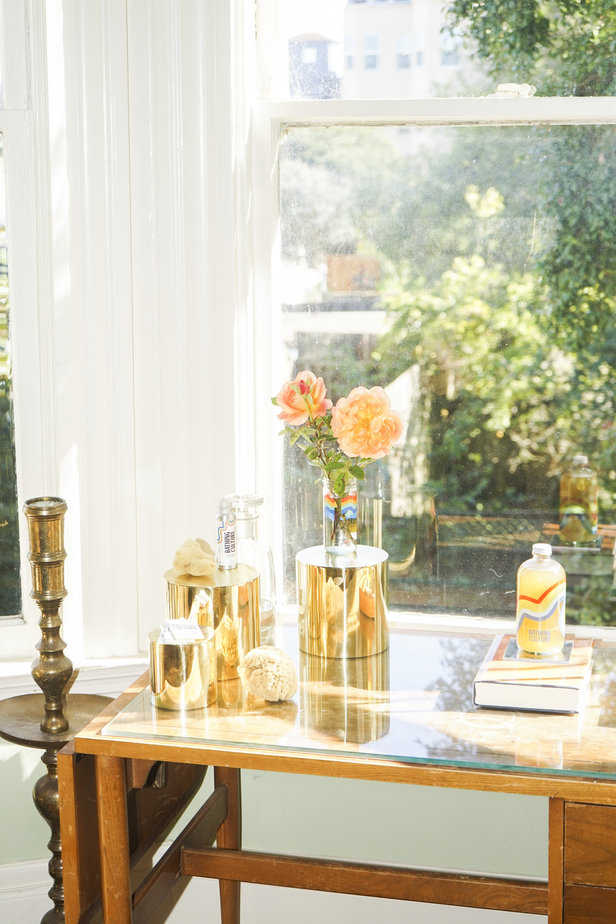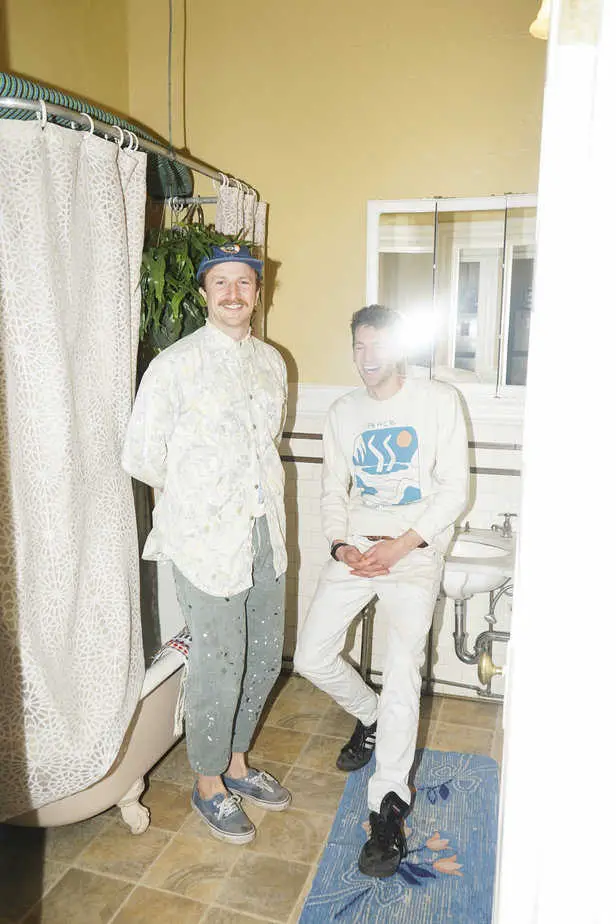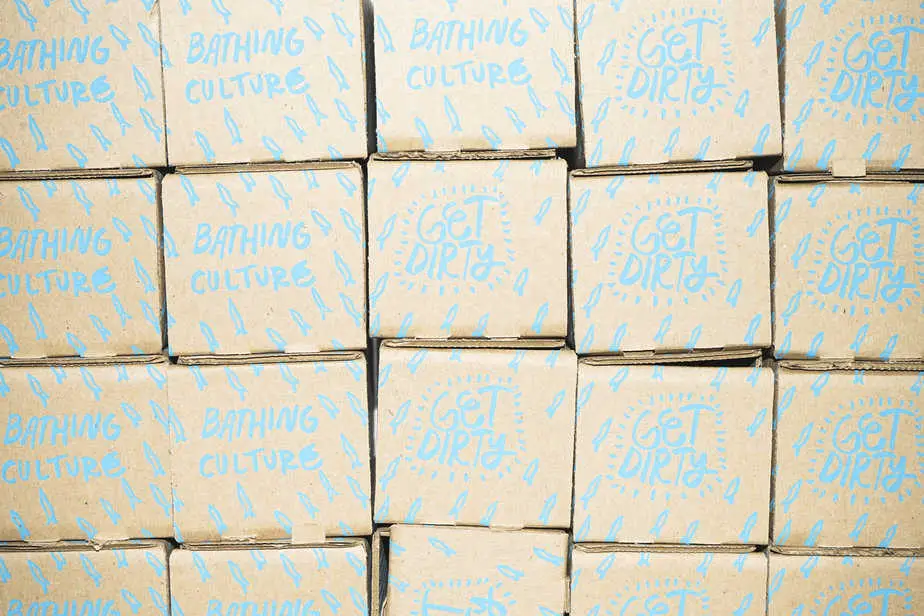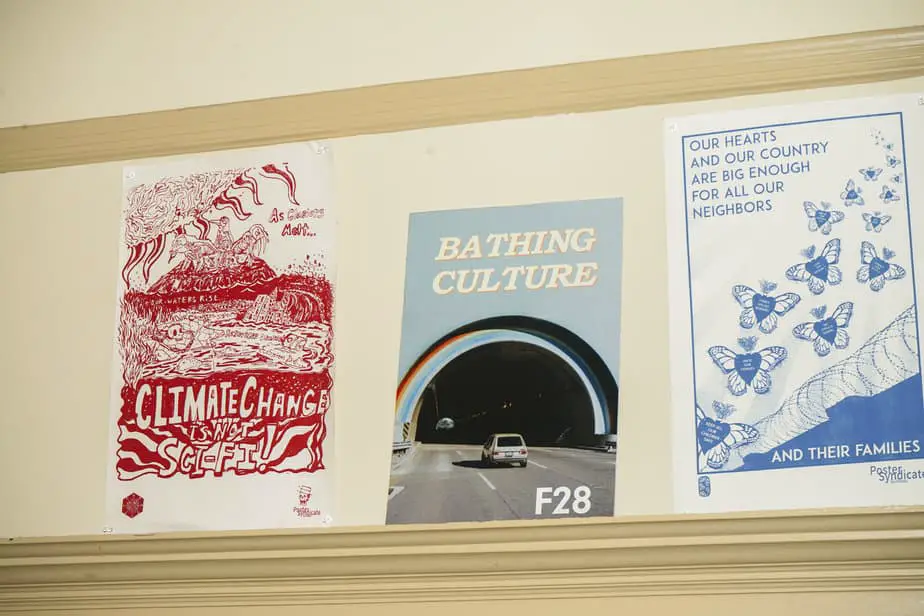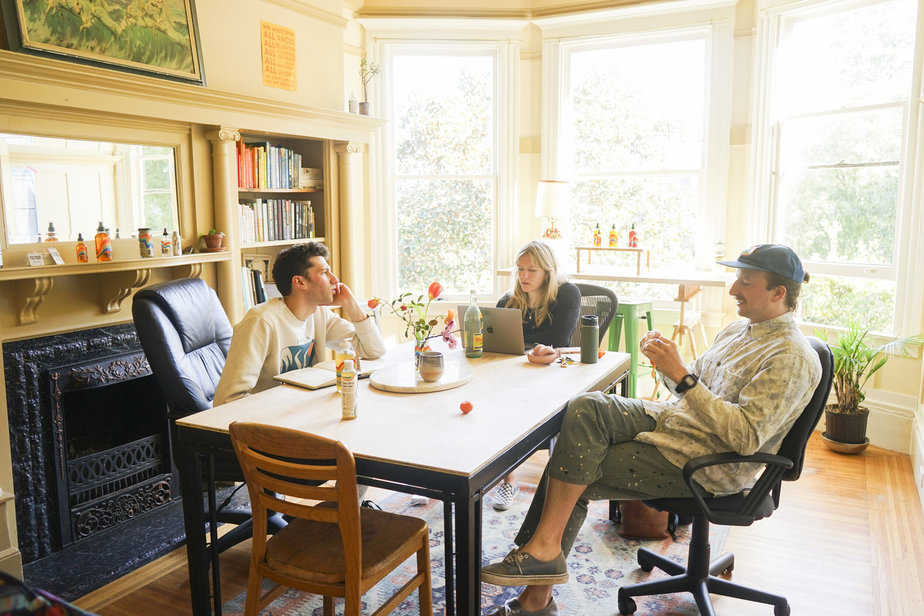And you may have an initial question: “is there such a thing as Bathing Culture?” Yes. There is. But it may not be the words you’re combining together. The duo describe their manifesto as “celebrating the simple necessity of bathing. How it bonds humanity and cultures across time and space…It’s ability to transform and bring joy. We believe in the art of bathing, the traditions it holds, and the future it will bring.” With a free-word association added into the mix: “swimming holes, skinny dips, sweat-inducing activities, surfing, saunas, whirlpools, spiral jetty, mud pits, other people’s unattended pools.”
So get to know a culture, you have to soak where they bathe. I made my way to Bathing Culture’s humble claw-foot tub in Haight Ashbury—the neighborhood, a perfect backdrop to their already Summer-of-Love-Fleetwood-Mac aesthetic. As I approach their shower curtains (as I make more bathroom analogies for an office)—Arnold greets me at the front door dawning a while and blue speckled button and white pants covered in paint. His energy reads like Baby Sun from the Teletubbies, he’s radiating golden waves of light as he invites me in.
He leads me up the steep staircase into a dim hallway that doesn’t really scream any personality but as soon as I enter the Bathing Culture HQ wafts, if not clouds, of citrus, amberwood, and every other worldly delight. All in that moment hitting my sense of smell. I can’t help but take in deep, uninterrupted breaths as we walk into Bathing Cultures’ conference room. “I’m so sorry, it smells so good in here,” I say to Hollinger who’s situated on his laptop, he smiles and approaches me for a firm handshake, he’s dawning a white crew neck sweater and jeans. After my nose settles into what I can describe as a decadent weekend spa retreat to the Redwoods, we sit down and just start to chat about everything sans Bathing Culture—”wow, they’re so comfortable and open,” I think to myself as the conversations goes from San Francisco, to rent, to dating, to funny anecdotes of the two. On one hand, they are just that open and comfortable, and on the other—as they admit to me before the interview starts, “we are dyslexic (if you see an Instagram post with a spelling error that’s most likely why) and met in high school at a specialized school called Kildonan. So sorry if we trail off—we’re really bad at this thing” Arnold tells me.
This factor, however, didn’t define their story but became a primer that worked stunningly for their blossoming business. “For three years while in school, Tim had the top bunk bed, I was below,” Arnold tells me, “we basically came of age together and built a pretty awesome friendship. It’s really our history and understanding each other’s character that’s led us to create Bathing Culture.” But how do bunk bed mates learning to live with dyslexia formulate a body-care business? Much like their friendship, it was a natural step in a new direction. The two working respective tech jobs—commuting daily together by bike, surfing, long distance running together—the two inseparable.
As the two are showing me around their Haight Ashbury HQ, Arnold is picking knick-knacks off the shelf and telling me their elaborate stories, “Tim and I find so many cool things on the street. Chairs, tables, lamps—though we’ve had to stop because we bring home too much [laughs]”—Hollinger chimes in, “he thinks everything is Wabi Sabi and sometimes it’s just trash [laughs]”. Arnold tells me as he’s showing me inside their bathroom where the “testing” of their products happen. Indicative of their ethos, posters of San Francisco summer’s yesteryear, surfboards that are freshly loved, and amber-colored vials of essential scents line the walls. Much like their eclecticism, their launch story is one for the books, as I ask how they came to be, the two look at each other with a smirk on their faces. “We wanted to throw a party for our launch on April 22nd, which is Earth Day,” Arnold answers, “Tim went out and sold Klondike bars just like a couple blocks from here on Haight street during 4/20 to raise money for an electric cave party. It was a liquid light cave show. We did it at Sutro caves and we lit it up in tripped out sixties liquid light projectors. And it was really cool.”
And the party was proven to be successful, starting out with friends, families, and funnily enough, cops—the duo set in motion their first couple of products. “I remember being by the table with all the soap and [cops] had flashlights on the soap and I was like, ‘uh, it’s a soap,’” Arnold recalls with a beaming smile on his face, “the cops were asking me ‘what is going on here? What is all this stuff?’ You know what I mean? It was so strange for them. They were starting to ask me questions about the setup [and how to use the soap]. It was really funny.”
But as high intensity surfers, runners, cyclists respectively—along with their friends and family, a getting sweaty and dirty lifestyle seemed to come with the territory. The two alongside their family members all had an open conscious about environmental safety and responsibility. The two recanting stories of their child-into-adulthood going all around the beauty and nature of Northern California, the days traveling with friends to parts untouched, and the illustrious appreciation for the natural world. “At the time, we were making soap for our friends, so we had this need for ourselves and those around us,” Tim injects as they show me ingredients in the variety of their soap product, “we really wanted an organic body wash that wouldn’t destroy our skin, that wouldn’t destroy the planet, that would biodegrade. We wanted the products to tell the story of the earth. We were going out to hot springs, we were taking our friends on these journeys. Then we would get home and take a shower, would go surfing and come back to the shower, trail running, come back to the shower.”
The two began to cook up the first iterations of the soap that had all of these components—working in Hollinger’s kitchen with one crockpot and a dream. With much guidance of Arnold’s mother who comes from a background of being a natural perfumer, the two bounced between her expertise and YouTube. “How to make soap,” Arnold recalls looking at Hollinger when they first started making. “It was well out of our wheelhouse, we had never done much of this—it was truly a learning experience for the both of us.”
With much more training under their belt and a refinement in their development process, the two created one of their most popular scents, Cathedral Grove. A Redwood canopy inspiration that homes a lot of the dirtiness that duo love and appreciate. “The first set is Cathedral Grove and that sparks Redwood forest canopies in Northern California. And that was kind of what we were really trying to go for when we were making them. We ultimately want to create a culture around bathing and the healing and meditation power behind it.” As we round-up the upstairs area of Bathing Culture, Arnold asks me, “want to see the basement?” This is where most of all Bathing Culture products are packaged and mailed weekly around the country. Ironically, if the “bathing” of Bathing Culture is upstairs, surrounded by ingredients and inspiration, the culture portion slow cooks in their fulfillment facility. Surrounded by culture’s most prolific posters and civic movements—the women’s march, march for our lives, and so many more encapsule the underside of their top floor office. I’m taken aback a bit but I shouldn’t be surprised, culture comes in so many colors, shapes, and sizes. “Doing this kind of community-driven business in San Francisco is really hard,” Arnold says with a slight sigh has both Hollinger and Arnold point out the pictures of their five years in business, “and so we have to be really creative about space and about how we’re thinking about making it in the city and making it work—keeping a piece of old San Francisco spirit alive. We love stories like The North face when they launched in North beach. They stole electricity from the power poles to keep their lights on. They went up there and had the Grateful Dead play on the roof for their launch party.”
SHOP BATH ESSENTIALS
It got me thinking. It’s not so much thinking about bathing as a culture but how bathing can get you to reconnect with the culture you know so well and identify with. For the duo, the culture behind environmental friendliness sticks with them like cement glue to a tile. “I knew that if we wanted to make more products, we wanted to address something where there was a problem. Body wash by volume is the most sold care product in the U.S. and it is awful, most of it—that was a huge need.”
A large majority of American consumer body and personal care contain silicone or micro plastics—these are used to exfoliate dead skin, make the skin smoother, and more. The Greatist put it into reality, “quite simply, microbeads are microplastics, or very small balls of plastic. Over the past 10 years they’ve become increasingly popular among producers of personal care products as a gentler alternative to natural exfoliants such as walnut shells. As of March 2014, there were more than 100 products containing microbeads on U.S. store shelves.” The report goes onto read: “These tiny microbeads can be eaten by marine organisms such as plankton, fish, seabirds, and larger organisms like the northern right whale, an endangered animal that could eat the plastic along with its food. Because microbeads absorb PCBs, that means that marine creatures are getting a dose of toxic chemicals along with their plastic appetizers.”
To minimize plastic waste whether externally or internally in the product, the duo opted in for reusable glass packaging, no micro and mini-micro stabilizers in the actual formulation itself. It became a love letter from Bathing Culture as a business to customers. In the early days of glass packaging, Arnold or Hollinger would bike to customer’s homes and by hand refill empty Cathedral Grove like they were milk boys of soap. But it didn’t stop there, to honor their customer’s respect for nature, hosting BYOB (bring your own bottle) parties to refill their product became a common way to celebrate everyone in one room.
“We didn’t have enough money to keep reordering glass bottles or gap labels. That’s where we’d start to have refill parties. People would come into our office, then we printed out like 30 different types of labels so that people could bring in their bottle and decorate it however they wanted. It was really fun,” Arnold recants around their conference table.
Hollinger in our interview wants to make it really clear when it comes to business however, “we’re not in the personal care business. We’re not in the organic business,” he says with straight certainty, “but we’re really in the transformation business. We are really trying to give people that reset, give people an experience that will transform them or transport them to these incredible experiences.” From what I deduced, giving people a moment to reflect on their personal cultures in the solitary confines of their tubs or showers.
But as a community-driven business, Arnold and Hollinger are a testament to honoring those who honored them. The power of word-of-mouth is one built in trust and that trust is something Bathing Culture thinks about often, “I think about it every day, is that anything culture is totally community-driven,” reiterates Hollinger, “what products we’re making next? We don’t reach out to stores, we’re not really great at that but we have community members who love the product and will go to the stores and be like,’ can you please carry this?’ And it was really an overnight thing, we were continuing to show up and we’d have these bottling parties and we’d invite whoever to come. And it was like mostly our friends and friends of friends to start. Then I remember we had a couple where there were people we didn’t know showing up. I was so nervous about that, but it was so exciting.”
“They like me, they really like me” rings through my mind as they tell me the copious amount of stories singing their hard work. It’s not hard to like Arnold and Hollinger. Their innate openness and hospitality draws hordes of the bathing obsessed coming back again and again—a pretty 90’s indicative poster that they scavenged off the street reads, “success doesn’t find you, you go to it.” One of Hollinger’s favorite things in the office. But as corny as it reads, it really spearheads on the idea that success to Arnold and Hollinger is found in creating systems that find fixes in an environmentally-friendly sense. Hollinger goes onto to say, “final piece I’ll say on the environmental friendliness topic and this is another topic we can like go off on for days. What we firmly believe in confronting the environmental crisis is that we don’t need to approach it with this total like defeatist, doom and gloom all or nothing approach. We need to show people and be part of this transition from a place of positivity and joy and that starts in the shower. Really taking care of ourselves before you can take care of your community.”
Much about culture is how the intersection of belief and community come together—how your ways of thinking can influence those around you. Now in 2020, Bathing Culture extends from the tub to real life and for Arnold, “And just seeing that community grow and helping people change the way that they kind of think about these everyday utilitarian products. It’s just like an amazing honor for us every day.”
// Finding Bathing Culture here or in-person here. Photography by Anthony Rogers.
